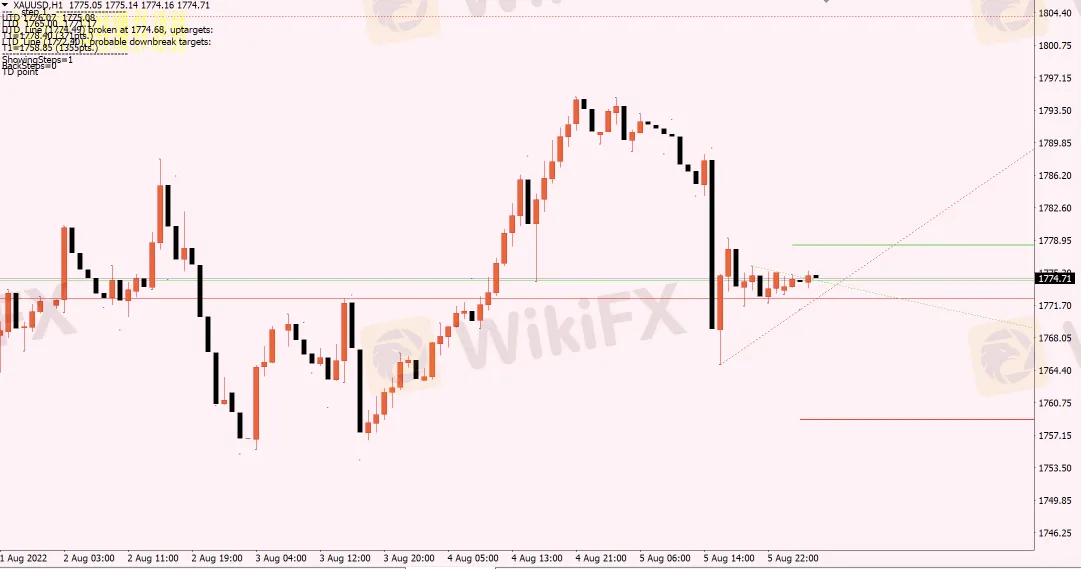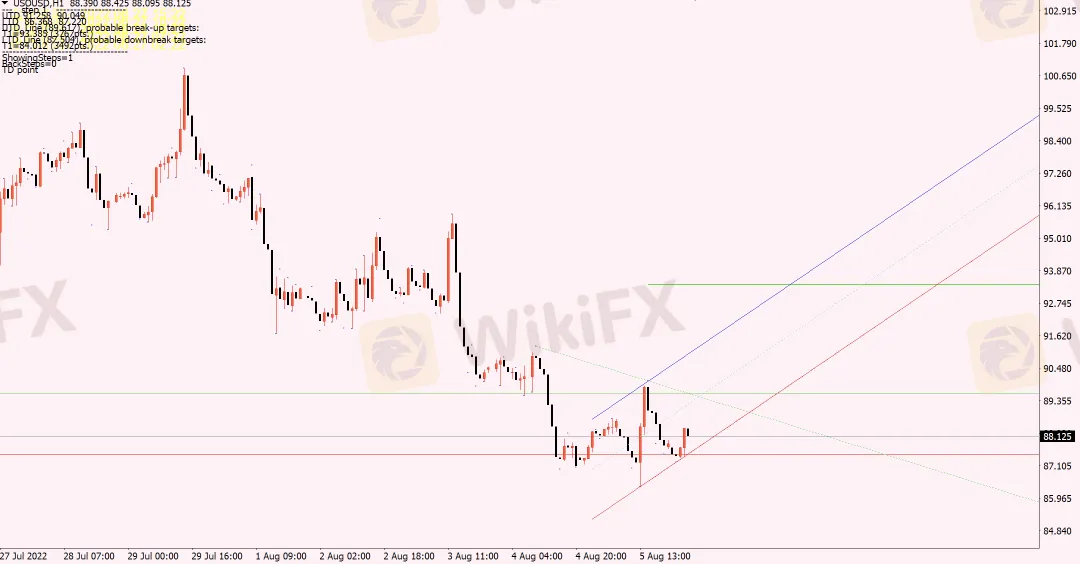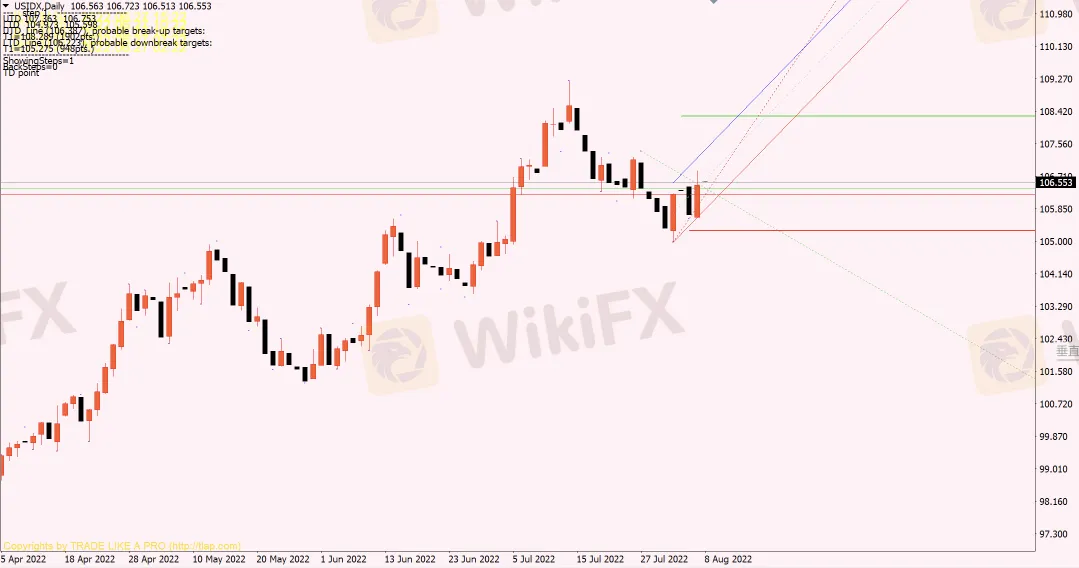Mohicans markets : Strong Jobs Data Eases Recession Fears The Fed May Continue to Raise Interest Rates Aggressively to Boost the Dollar
Sommario:On August 05, last Friday, driven by the non-agricultural data, the US dollar index rose sharply by nearly 100 points in the short-term, and closed up 0.775% at 106.58. The 10-year US bond yield exceeded 2.8% after the non-agricultural announcement. The inversion of U.S. 2-year and 10-year Treasury yields widened to 45 basis points, the highest since August 2000.

Financial Events Today
11:00 New Zealand's inflation expectations for the next two years in the third quarter (%), previous value was 3.29, expected value -- , published value: to be released
11:00 New Zealand's 1-year inflation rate in the third quarter - quarterly rolling (%), previous value 4.88, expected value -- , published value: to be released
13:45 Switzerland's July unadjusted unemployment rate (%), previous value of 2, expected value of 2, published value: to be released
13:45 Switzerland July seasonally adjusted unemployment rate (%), previous value was 2.2, expected value was 2.2, published value: to be released
16:30 Eurozone August Sentix Investor Confidence Index, previous value -26.4, expected value -24.7, published value: to be released
risk warning:☆ Moscow Exchange said that starting Monday,August 8, investors from “friendly” countries will be allowed to return to Russia's stock, bond, REPO, and derivatives markets.
This week will focus on the following key economic data and events:
①Monday Sentix Investor Confidence Index in the Eurozone in August;
②Tuesday China's July M2 money supply annual rate, China's July social financing scale, EIA's monthly short-term energy outlook report, API crude oil inventories;
③Wednesday China's July PPI annual rate, China's July CPI annual rate, the US July CPI annual rate not seasonally adjusted, Chicago Fed President Evans speech, Minneapolis Fed President Kashkari speech, EIA crude oil inventories;
④ Thursday U.S. July PPI annual rate, U.S. initial jobless claims for the week ended August 6, IEA‘s monthly crude oil market report, and OPEC’s monthly crude oil market report;
⑤Last Friday UK June GDP monthly rate, UK June industrial output monthly rate, US July import price index annual rate, US August University of Michigan consumer confidence index initial value, US oil drilling for the week ended August 12 total
Global Views - List of Major Markets
On August 05, last Friday, driven by the non-agricultural data, the US dollar index rose sharply by nearly 100 points in the short-term, and closed up 0.775% at 106.58. The 10-year US bond yield exceeded 2.8% after the non-agricultural announcement. The inversion of U.S. 2-year and 10-year Treasury yields widened to 45 basis points, the highest since August 2000. Spot gold dived by about $20 from around 1790 after the non-agricultural announcement, once fell below the $1770 mark, and finally closed down 0.94% at $1774.15 per ounce; spot silver fell below the $20 mark and closed down 1.34% at $19.88 /ounce. WTI crude oil rose 3% to hit $90 per barrel at the beginning of the U.S. session, and Brent crude oil once stood at $96/barrel, and then the two oils fell again. As of the close, WTI crude oil closed up 0.58% at US$88.53 per barrel; Brent crude oil closed up 0.84% at US$94.35 per barrel, both hitting the biggest weekly decline since the week of April 1. The European Council approved a deal to cut gas demand by 15%, amid concerns that some of that demand could be diverted to crude oil. U.S. stocks closed mixed. The Dow Jones closed up 0.23% at 32,801.51 points; the S&P 500 closed down 0.18% at 4,144.30 points; the Nasdaq Composite closed down 0.50% at 12,657.55 points. New energy vehicle stocks, popular Chinese concept stocks, and silver stocks were among the top losers. European stocks generally fell. Germany's DAX30 index closed down 0.60% at 13,580.26 points; Britain's FTSE 100 index closed down 0.12% at 7,439.45 points; France's CAC40 index closed down 0.63% at 6,472.35 points; the European Stoxx 50 index closed at 6,472.35 points. It fell 0.77% to 3725.75 points. Bitcoin traded above $23,000 over the weekend, while Ethereum topped $1,700 per piece.
Precious Metal
In the early trading hours of Monday, August 8, spot gold fluctuated within a narrow range and is currently trading around US$1,774 per ounce. On Friday, spot gold fell from a nearly one-month high. On the one hand, the US non-farm payrolls data for July showed employment. The market is strong, the market's expectations for the Fed to raise interest rates by 75 basis points in September have risen sharply, and the US dollar and US bond yields have risen, suppressing the price of gold; on the other hand, the 60-day moving average also suppressed the price of gold. However, given the still tense geopolitical situation, there was bargain hunting to support gold prices.
This week, the market will focus on the U.S. CPI data in July. Some analysts expect high inflation in the U.S. to further boost expectations for a 75 basis point rate hike by the Federal Reserve in September, which is not good for gold prices.

The fundamentals are mainly bearish
[U.S. jobs rose the most since February in July, greatly easing recession fears]
[The probability of the Fed raising interest rates by 75 basis points in September rose to 68%]
[U.S. dollar rose across the board on Friday, and U.S. bond yields generally rose]
Fundamentals are mostly bullish
[IAEA warns of shelling of Ukrainian nuclear power plant, Russia shells “dozens” of towns]
[The Russian Ministry of Defense said that a warehouse containing 45,000 tons of NATO-supplied ammunition was destroyed in Ukraine]
[The Canadian military will send personnel to the UK to provide recruit training for Ukraine]
[US poll: Americans are pessimistic about the current state of the economy and future trends]
[Iran analyst: The United States still does not have enough negotiation sincerity in the new round of negotiations to resume the implementation of the Iran nuclear deal]
[USD net long bets fell to $17.27 billion in the latest week]
Speculators' net-long bets on the dollar dipped in the latest week, according to Reuters calculations and data from the U.S. Commodity Futures Trading Commission released on Friday. The net long dollar position fell to $17.27 billion in the week ended Aug. 2 from $18.46 billion the previous week. U.S. dollar positions at the International Moary Market in Chicago are calculated based on net positions in six major currencies: Japanese yen, Euro, British pound, Swiss franc, Canadian dollar and Australian dollar.
On the whole, the good performance of non-agricultural data will boost the Feds expectation of raising interest rates by 75 basis points in September in the short term, which is biased to support the dollar and bearish the price of gold in the short term, but the geopolitical situation is relatively tense. Before breaking the first-line support of 1750, the market outlook gold prices are still slightly inclined to shock upside.
Crude
In early trading on Monday, August 8, U.S. oil traded around $88.25 per barrel, and oil prices were blocked from rebounding on Friday, although they were once boosted by strong U.S. job growth data, but they were limited by a new round of global new crown epidemics Under the explosive spread, demand concerns are affected, and the rebound is hindered. Under the influence of vigilance against the epidemic, there are still downside risks for oil prices in the short term.

Bullish factors affecting oil prices
[U.S. job growth in July greatly eases recession fears]
[Geographical tension Ukraine nuclear power plant was shelled again]
[U.S. drilling data declines]
[The United States still does not have enough negotiation sincerity in the new round of negotiations to resume the implementation of the Iran nuclear deal]
[An oil reserve base in Cuba was struck by lightning and caused a fire]
Negative factors affecting oil prices
[S&P 500 closed down, strong employment data rekindled interest rate hike concerns]
[Japan is the most serious epidemic in the world]
On the whole, the strong employment data in the United States has eased concerns about an economic recession, coupled with the continued geopolitical tensions between Russia and Ukraine, oil prices have been supported. However, the global epidemic is spreading, and short-term oil prices may be dragged down.
Foreign Exchange
In early trading hours on Monday, August 8, Beijing time, the U.S. dollar index rose slightly and is currently trading around 106.66. Data on Friday showed U.S. non-farm payrolls increased by 528,000 in July, the largest gain since February and well above economists' expectations. The U.S. dollar index, which extended gains sharply after the report, was last up 0.79% at 106.58.

The stronger-than-expected U.S. non-farm payrolls report for July suggests the Fed may need to continue aggressive rate hikes in the near term. The dollar rose on Friday, posting its biggest one-day percentage gain against the yen since mid-June, before closing up 1.58% at 134.98.
GBP/USD closed down 0.71% on Friday at 1.2072. The Bank of England raised interest rates by 50 basis points on Thursday, the most in 27 years, even as it warned that a prolonged recession is looming and the economy will shrink from the fourth quarter as the central bank moves quickly to curb rising inflation.
“We don't think a 50bps rate hike by the Bank of England last Thursday would be enough to support the pound over the next few months, which has been affected by a hawkish Fed,” said UBS Global Wealth Management strategist Thomas Flury.
Uncertainty over inflation, energy supplies and the political outlook could weigh on GBP/USD in the coming months, he believes. The UK's second-quarter GDP figures on Friday should confirm the negative sentiment.
EUR/USD was down 0.65% at 1.017877 on Friday. Foreign exchange analysts say a drop in the Rhine, which affects Germany's traffic and economy, is a big reason for the bearish euro.
Strategist Frances Cheung of OCBC Bank said worries about euro zone growth, the energy crisis and a hawkish Federal Reserve are all holding back the euro's upside against the dollar. In Germany, water levels on the Rhine have fallen to their lowest level since 2018, making it almost impossible to transport coal, sand, chemicals and other commodities. This could affect trade, economic growth in Germany and the euro zone, and exacerbate energy problems.
International News
1.The US non-farm payrolls increased by 528,000 seasonally adjusted in July which was expected to 250,000, the largest increase since February this year.
2.Buffett's Berkshire Hathaway posted a net loss of $43.755 billion in Q2, compared with market expectations of a profit of $6.703 billion, including a huge portfolio loss of $53 billion; Q2 total revenue of $76.18 billion was slightly above consensus.
3. US polls: Americans are pessimistic about the current state of the economy and future trends
4. Israel launched a new round of airstrikes on the Gaza Strip last Friday, code named “Dawn”.
5. Iran and the parties involved in the Iran nuclear deal are holding a new round of negotiations on the resumption of the implementation of the Iran nuclear deal in Vienna, the capital of Austria
6. On August 7, the Joint Coordination Center on the issue of outbound agricultural products from ports in the Black Sea issued a statement saying that on the same day, two grain ships were authorized to depart from Ukrainian ports on the 8th.
7. Iraq is negotiating an increase in gas purchases from Iran.
8. EU countries will be forced to compete with Asia over Russian LNG
9. Japanese Prime Minister Fumio Kishida is expected to carry out a cabinet reshuffle and senior personnel reshuffle of the Liberal Democratic Party (LDP) on August 10. Abe's younger brother, Japanese Defense Minister Kishi Nobuo, may be replaced.
10. According to Interfax: The Russian Ministry of Agriculture proposes to set up seed import quotas.
11. Prime Minister of Ukraine: Ukraine's natural gas storage is 12.1 billion cubic meters;
12. The President of Russia and Turkey ended the 4-hour Sochi talks.
13. Russia Moscow Exchange Announcement: From August 8, non-residents from friendly countries will be allowed to enter the forward market for trading.
14. On August 5, Ukraine's Zaporozhye nuclear power plant was shelled twice, and Russia and Ukraine blamed each other for the two attacks.
15. The U.S. Senate has passed a landmark tax, climate and health care bill (the Inflation Cuts Act), which has been sent to the House of Representatives and is expected to pass on Friday.
Institutional Point of View
1. TD Securities: The Canadian dollar may fall further
① TD Securities said that Canadas July employment data was weaker than expected, raising the threshold for the Bank of Canada to raise interest rates by 50 basis points in September, and the Canadian dollar may fall further;
②1.30 will be the next important position for USD/CAD, the currency pair may retest 1.32, but it may take a little more time.
2. IG analyst: GBP/USD faces further downside risks due to US and UK economic differences
① IG analyst Chris Beauchamp said that after the Bank of England warned that the British economy may be in recession, the strong employment data in the United States highlighted the gap between the US and British economies, and the pound against the dollar seemed prone to further declines. Sterling in particular looks likely to weaken further as the gap between the US and UK widens.
② A further drop in the pound will offset most of the Bank of England's efforts to control inflation, allowing the previously bleak outlook to persist. Sterling fell 0.9% to $1.2047 after falling to its lowest level in more than a week at $1.2004, data from FactSet showed.
3. Commonwealth Bank of Australia: Forecast EUR/USD to fall below parity in the coming weeks
Joseph Capurso, head of international economics at the Commonwealth Bank of Australia, said: “We still expect EUR/USD to trade below parity over the next few weeks, and it won't be short-lived.”
4. Bank of Montreal: The Bank of Canada is expected to continue raising interest rates, but may not be as aggressive as before
① Douglas Porter, chief economist at Bank of Montreal, said the Canadian job market is clearly losing momentum, with weak employment data in July highlighting a decline in part-time and full-time jobs, as well as weakness in the private and public sectors, while employment in June fell completely because of the decline in self-employed.
② The downward trend of the labor force participation rate deserves close attention, and the labor market may be further tightened. For the Bank of Canada, the conclusion that can be drawn is that although economic growth has cooled significantly, the situation is still “tight” and wages are rising, which is in line with expectations for another rate hike at the September meeting, but the rate hike may not be as much as 50 in July basis points.
5. Commerzbank: The labor market cooling that the Fed hopes has failed to materialize, and the call for a 75 basis point interest rate hike is getting louder
① With the U.S. economy contracting in the first two quarters of 2022, the definition of a “technical recession” popular in financial markets has been met. However, the labor market has been very strong so far, which will ultimately determine whether the U.S. economy is headed for a true recession as unemployment rises and consumer spending falls.
② In the press conference after the July meeting, Fed Chairman Powell explicitly mentioned the two employment reports released before the September meeting, which will help determine whether the Fed must put a strong brake on raising interest rates. At present, the non-farm payrolls report has been released, showing that the labor market is still hot, and the cooling that the Fed hopes to reduce inflation pressure has failed to materialize. So calls for another 75bps rate hike by the Fed in September could grow louder.
6. Asset manager Safra Sarasin: Eurozone recession in winter increasingly likely
①A report by asset management firm Safra Sarasin shows that economic growth in the euro zone was surprisingly strong in the first half of 2022, at 1.2%, about 2% stronger than the US economy. In the third quarter, some southern European countries are expected to benefit from a recovery in tourism, but the overall trend in economic growth has declined significantly;
②Safra Sarasin's chief economist said it is increasingly likely that the euro zone will experience a recession this winter. Germany, the euro zone's largest economy, will be hit especially hard and may already be in recession.
7. Oxford Economics: Eurozone industry expected to fall into recession around year-end to early next year
① According to Mateuz Urban, an economist at Oxford Economics, industrial production in the major euro zone economies unexpectedly increased in June. German industry increased by 0.4% month-on-month, French industry increased by 1.4%, and Spanish industry increased by 1.1%. But Italy was the only exception, where a collapse in car production dragged down manufacturing output, which fell 2.1% in June;
②According to the national data released last Friday, Oxford Economics estimated that the industrial output value of the euro zone increased by 0.2% month-on-month in June and 0.3% month-on-month in the second quarter. But euro zone industry is expected to slip into recession early next year, given weakening demand, deteriorating sentiment and the growing likelihood that gas rationing will begin in winter.
Declaration|Disclaimer
Disclaimer: The information contained in this material is for general advice only. It does not take into account your investment goals, financial situation or special needs. Mohicans Markets has made every effort to ensure the accuracy of the information as of the date of publication. Mohicans Markets makes no warranties or representations regarding this material. The examples in this material are for illustration only. To the extent permitted by law, Mohicans Markets and its employees shall not be liable for any loss or damage arising in any way, including negligence, from any information provided or omitted from this material. The features of Mohicans Markets products, including applicable fees and charges, are outlined in the Product Disclosure Statement available on the Mohicans Markets website www.mhmmarkets.com and you should consider before deciding to deal with these products. Derivatives can be risky; losses can exceed your initial payment. Mohicans Markets recommends that you seek independent advice.
Mohicans Markets, (abbreviation: MHMarkets or MHM, Chinese name: Mai hui),Australian Financial Services License No. 001296777.
WikiFX Trader
XM
EC markets
EBC
octa
Exness
Vantage
XM
EC markets
EBC
octa
Exness
Vantage
WikiFX Trader
XM
EC markets
EBC
octa
Exness
Vantage
XM
EC markets
EBC
octa
Exness
Vantage
Rate Calc


